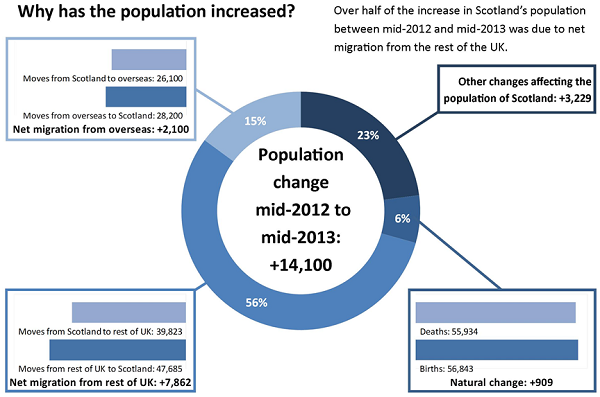Further Information on Scotland’s Population Published Today
Further Information on Scotland’s Population Published Today

Statistics published today by the National Records of Scotland (NRS) show that between mid-2012 and mid-2013 the populations of 20 Council areas in Scotland increased while the populations of the remaining 12 decreased or remained the same. The data also shows that the age structure of Scotland’s population varies across the country – overall, the median age (the age at which half the population is older and half is younger) of the population in Scotland was 41, but this ranged from 36 in big city areas to 47 in more rural Council areas. Today’s statistics break down further the headline figures published 30 April 2014 on this website showed that the estimated population of Scotland was 5,327,700 in mid-2013, the highest ever and an increase of 14,100 on the previous year.
Main findings
Scotland
- The estimated population of Scotland on 30 June 2013 was 5,327,700, the highest ever and an increase of 14,100 from the previous year.
- There were approximately 2,586,530 males and 2,741,170 females.
- The population increased because approximately 910 more people were born than died, and because the number of people coming into Scotland exceeded the number leaving by approximately 9,960 between mid-2012 and mid-2013. Other changes, such as in armed forces and prisoners, resulted in a gain of approximately 3,230 people. Infographic 1 provides more information on why Scotland’s population has increased.
Infographic 1
Age of migrants arriving in Scotland
- Migrants to Scotland tended to be younger than the general population. Of in-migrants to Scotland, 49 per cent from the rest of the UK and 69 per cent of those from overseas were aged 16-34 years, yet in the resident population only 25 per cent were in this age group.
- Only six per cent of people coming to Scotland from the rest of the UK and two per cent of people entering from overseas were aged 65 and over. Scotland had a net gain of UK migrants in every age group, except those aged 25-34 and 75-84, and a net loss of international migrants for all ages over 25.
Age structure of Scotland’s population varies across the country
- The median age (the age at which half the population is older and half is younger) of the population in Scotland was 41.
- The median age was lower in big city areas than in more rural Council areas. For example, the median age was 36 in Aberdeen City, the City of Edinburgh and Glasgow City and 47 in Argyll & Bute and Dumfries & Galloway.
The population of 20 Council areas have increased and 12 have decreased or remained the same
- Among Council areas, between mid-2012 and mid-2013, Moray had the largest percentage population increase at +1.5 per cent, followed by Argyll & Bute (+1.3 per cent) and the City of Edinburgh and Aberdeen City (+1.0 per cent). West Dunbartonshire and Eilean Siar had the largest percentage population decrease at -0.6 per cent, followed by North Ayrshire and Inverclyde and (-0.5 per cent) and Dumfries & Galloway (-0.4 per cent).
- The populations of the City of Edinburgh and Aberdeen City increased because of more births than deaths and net in-migration. (The populations in Moray and Argyll & Bute increased primarily because of other changes such as changes in the number of armed forces.) In contrast, the populations of West Dunbartonshire, North Ayrshire and Inverclyde decreased because of more deaths than births and net out-migration. The populations in Eilean Siar and Dumfries & Galloway decreased primarily because of more deaths than births.
- On average, in mid-2013 there were 68 people per square kilometre in Scotland, ranging from 9 people per square kilometre in Eilean Siar and Highland to 3,415 people per square kilometre in Glasgow City Council area.
The full publication Mid-2013 Population Estimates Scotland is available on the NRS website.
